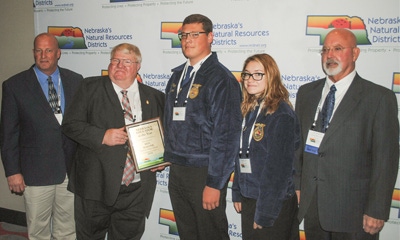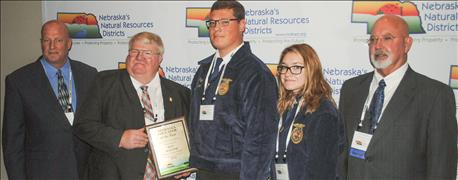
Ken Malone first started teaching 41 years ago. During that time, he has seen tremendous changes, not only in agriculture production methods, but also in how he prepares high school students for careers in the industry. Malone, who is the Palmyra FFA instructor, was recently named Educator of the Year at the Nebraska Association of Natural Resources Districts state convention in Kearney.

REWARDING CAREER: Ken Malone (second from left), received the NARD Educator of the Year award at the organization's annual meeting in Kearney recently. Pictured with Malone are David Bottrell (left) with Palmyra Public Schools; Kord Haight and Abby Lewis, Palmyra FFA members; and Jim Bendfeldt, NARD president.
Today, the biggest challenge for students is becoming aware of all the career choices they have in agriculture, Malone explains. "In the early years, major career preparation for students was in the ag production industry, or sows, cows and plows as the saying goes," he says. "There was little emphasis on mechanics and agriculture sales."
In the 1980s and ’90s, there was a greater need for FFA and agriculture education, in general, to include in career preparation an emphasis on agriculture business, food processing, natural resources, technology and science research, Malone says. "These careers were the fast-growing areas needed to expand the fast growth of the changing industry," he says. "We were marketing globally, so production agriculture needed more services for the increased demand for products, and we needed to be a forerunner in protecting our environment with all of those changes."
Now, ag education and FFA recognize 47 different proficiency areas, ranging from ag communications to wildlife. "So if students want to be involved in agriculture, there is plenty of opportunity one way or another," Malone notes. "It just needs to be researched and discovered by them."
He says that protection of natural resources has always been at the forefront of agriculture, because farmers are stewards of the land and water to provide for our future needs. Malone recalls USDA programs ranging from the "set-aside" programs in the 1970s, to Conservation Reserve Program and shelterbelt plantings in the 1980s, to all kinds of new techniques currently being employed to reduce soil erosion and protect groundwater.
His interest in natural resources has also driven his involvement in the State Land Judging Contest, where he has served as state coordinator for the past 20 years. "Soil is one of the most, if not the most, important of our natural resources of our environment," Malone says. "The improvements that have been made in ag production chemicals and inputs with our new technology has immensely helped with the protection of our resources," he explains. "The students I teach now are not as directly related or from the ag production sector, and they are more aware of the consumer drive and concern for our food and resources protection. We have to make them aware that ag production is one of the main contributors for natural resources protection."
You can learn more about Nebraska's NRDs and natural resources programs at nrdnet.org.
About the Author(s)
You May Also Like






